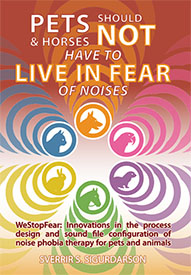 The text on this page is from the book "Pets and Horses Should Not Have To Live In Fear Of Noises" The book is available on Amazon.com as Print version or Kindle version.
The text on this page is from the book "Pets and Horses Should Not Have To Live In Fear Of Noises" The book is available on Amazon.com as Print version or Kindle version. (From page 127 of the book)
Comparison of the conventional method and WeStopFear’s Simple Secure Steps
A detailed breakdown of the difference between the conventional desensitization method and the WeStopFear Simple Secure Steps with the three innovations of Volume Anchor, Ascending Loudness and Natural Intervals.
In some ways similar, in some ways different
First is a comparison of the factors that are different, and below that is an overview of factors that are basically the same in both methods.
Infographic: Comparison of conventional and WeStopFear
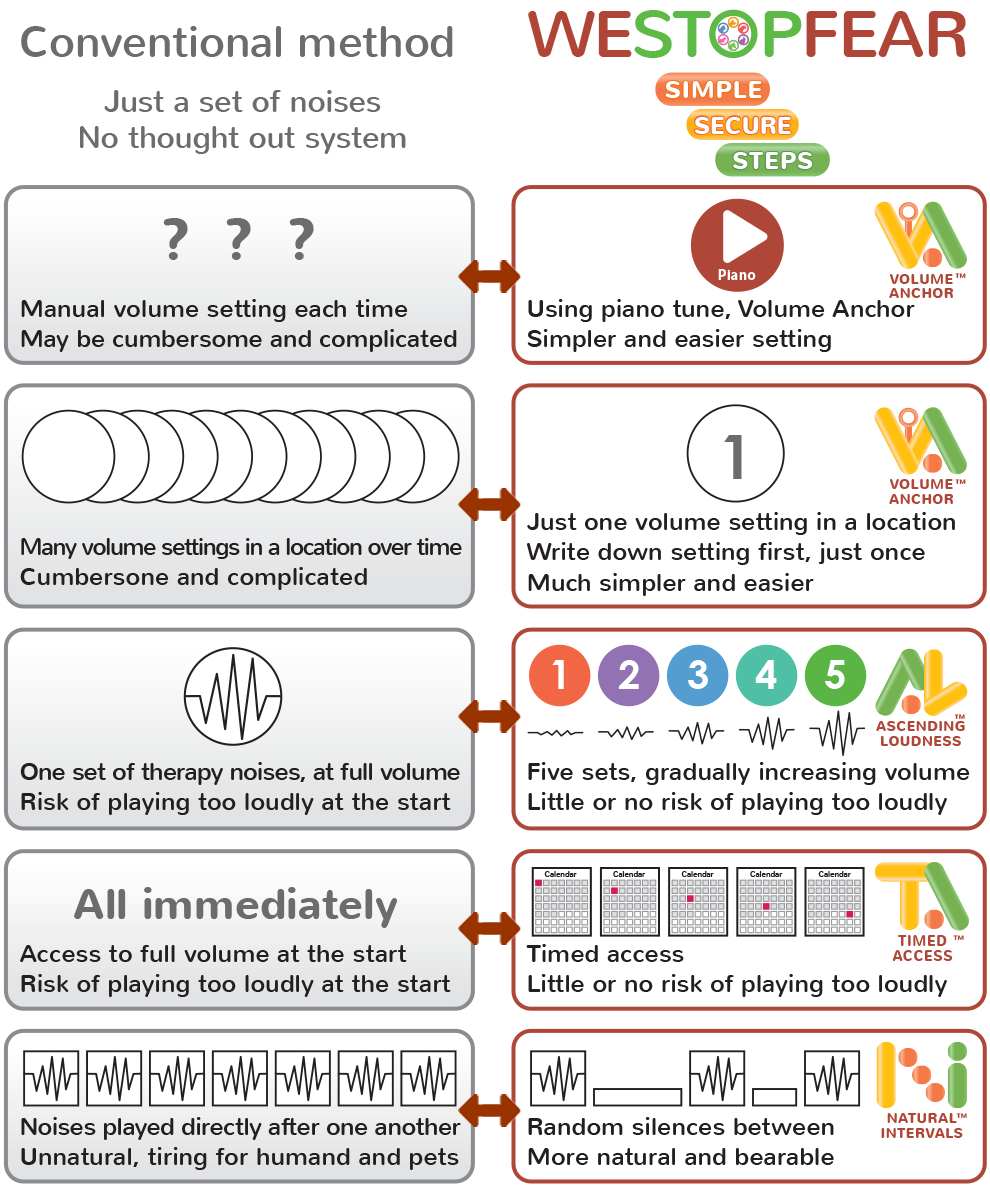
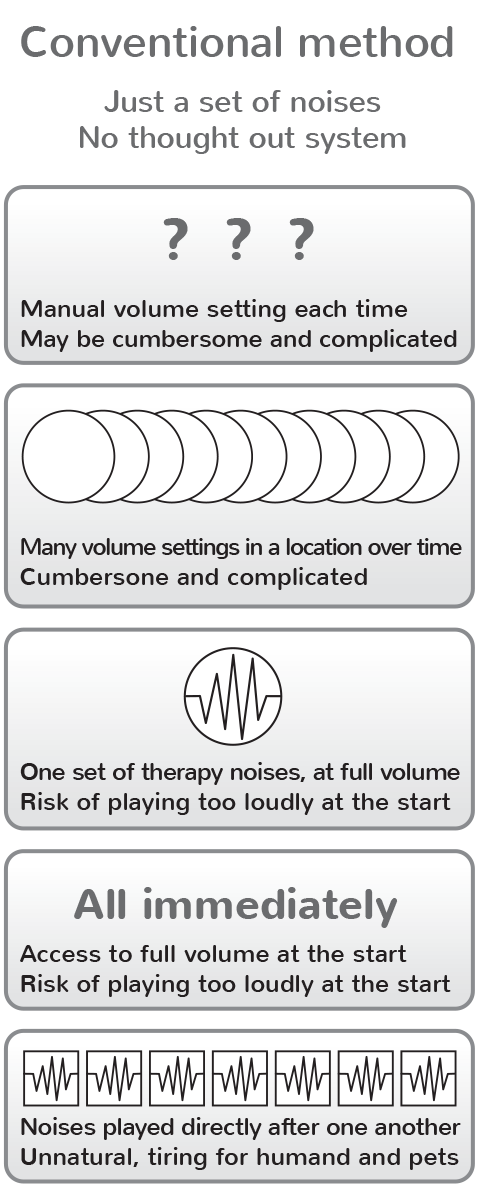
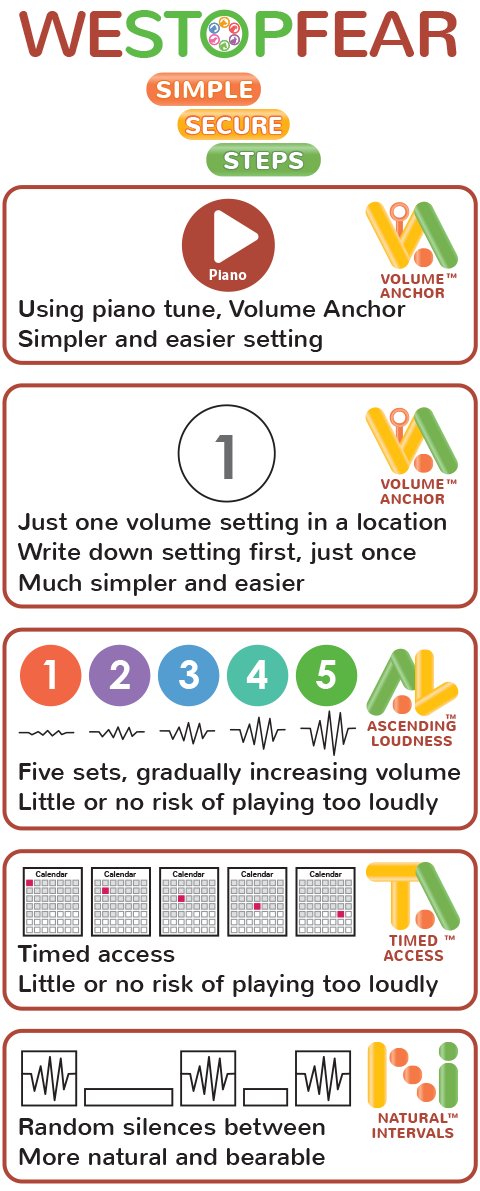
The factors that are different are in short:
A1. A systematically thought-out process design
A2. Setting the volume (on different types of playback devices)
A3. The number of soundtrack sets
A4. Timed access to audio track sets
A5. The continuity of the sounds and natural silences
A6. Comprehensiveness of instructions
A8. Ongoing encouragement in future maintenance
A. Factors that are different
A1. A systematically thought-out process design
Conventional method
The conventional method isn’t really carefully thought out as a system. It is simply a set of therapy sounds, some instructions, and then you play them and manually adjust the volume setting on the playback device.
![]()
The WeStopFear solution is systematically thought out process design, where the audio results that are required to implement the therapy, and the process steps and adjustments you need to manage to deliver them for the animal were carefully analyzed using the method of process analysis and process re-design used in industry and business.
The hope is that this will result in a method that is simpler and easier to implement, and safer and more natural as well. This has been given the name Simple Secure Steps™.

A2. Setting the volume
Conventional method
The handler must set the volume manually each time with high precision, on the playback device in a location, setting it to very low in the first session(s), then gradually increase over subsequent sessions and manage the volume correctly, and end the volume setting at full volume in the final sessions where the pet has become desensitized to the sounds. This is cumbersome and can be complicated.
![]()
The handler will set the volume on the playback device used in a location by playing the piano tune, the Volume Anchor™, so that the volume is at a normal listening level (not dinner or background music low, not rock concert loud, but in between). This volume setting will be used unchanged in all subsequent sessions, on that playback device in that location.

The whole process of volume setting is different based on if the playback device has 1. markings by the volume button or shows the volume setting as a number on a digital screen, or 2. if there are no markings by the volume button or the volume setting isn’t shown with a number or in any other way.
A2-1. Setting the volume (audio playback device with volume markings or the audio volume shown on a digital screen)
Conventional method
On a playback device with markings by the volume button, or the volume is shown as a number on a digital screen: The handler can write down the marking or volume number which will be low in the beginning (set at 1 or 2 on a scale of 1 to 10), and retrieve the paper with the information each time, and gradually increase the volume in the sessions over weeks, writing down the current volume each time. In the end, the volume setting is the one that
![]()
On a playback device with markings by the volume button, or the volume is shown as a number on a digital screen: The handler only needs to play the piano tune, the Volume Anchor, once to anchor the right volume, then write down the volume setting once for that playback device in that location, and the volume will be the same throughout the whole process from Step 1 to Step 5 and into the future maintenance stage. The handler will write down what the volume setting is and retrieve that information and set the volume according to that each time in that location on that playback device.
So in this case, the handler needs to play the piano tune only once, write down the volume setting on that playback device in that location and store the information, and then do the therapy with that volume setting every time through out the entire process, and also into the subsequent maintenance stage.
A2-2. Setting the volume (audio playback device with NO volume markings)
Conventional method
On a playback device with NO markings by the volume button, or the volume is NOT visible as a number on a digital screen: The handler must set the volume manually each time, and must have a feeling for what the volume is approximately, and will set it to very low in the first sessions, to increasing levels of medium volume in the ongoing sessions, and set it to full volume in the last sessions.
![]()
On a playback device with NO markings by the volume button, or the volume is NOT visible as a number on a digital screen: The handler will play the piano tune, the Volume Anchor, in the beginning (preferably a few minutes before starting the session) and set the volume so that the piano tune is at a good listening level. Wait a bit and then start playing the therapy sound set on random that corresponds to the current Step (in the range from Step 1 to Step 5).
A3. The number of soundtrack sets
Conventional method
This includes ONE set or collection of therapy noises, for instance on a CD disc (which has been the most common form), or a set of MP3 sounds. The volume of the therapy sounds is full volume in this format, and therefore the handler must carefully set the volume level correctly based on where in the process the pet is at and do that with great care. This can be cumbersome and complicated, perhaps on different playback devices in different locations.
The risk: In the first stages of the process, the sounds are supposed to be very low, so low that the animal isn’t alarmed. With this setup, it can accidentally happen that the volume setting is incorrect leading to the sounds being played much too loudly. That could give the animal a shock and send it into a fear of the noise. The damage could be done, leading to a setback that can be difficult to heal. Of course, no one is going to make that mistake, until one day the mistake is made never the less, and a damaging consequence is possible. This risk is inherent in the conventional, one sounds set.
![]()
This included FIVE sets or five versions of a collection of therapy noises. The sets are marked for Step 1, 2, 3, 4 and 5. The handler must start the process with Step 1 and finish it with Step 5.

The set volume level of the therapy noises is different in each of the set:
Step 1, the volume is set at very low, like a whisper.
Step 2 is low, like a phenomenon 50-100 meters away.
Step 3 is of medium volume.
Step 4 is louder, like a phenomenon 10-30 meters away.
Step 5, the sound files are at full volume, like sounds that are heard at the highest when they appear in real.
This is the Ascending Loudness feature of the Simple Secure Steps.

As said before, the volume setting on the playback device is the same throughout all five steps, it is anchored in the same setting which is the Volume Anchor, which makes setting the volume much easier and simpler. The volume is set by playing the piano tune as said before. That’s the simple part of the Simple Secure Steps.
As the volume of the sounds in Step 1 is pre-set very low, the risk inherent in the conventional method, of playing the sounds too high early in the process, should be close to eliminated. You simply cannot make that mistake. It has been designed out of the system. This is the secure part of the Simple Secure Steps.
A4. Timed access to audio track sets
Conventional method
There is just one set of therapy noise tracks, and that set is at full volume. The handler has, of course, full access to it in the beginning.
It is possible to play the sounds too loudly in the beginning. That could give the animal a shock and send it into a fear of the noise.
![]()
There are five sets of therapy noise tracks, one for each of the five steps. In the beginning (in the audio streaming), the handler only gets access to the set that belongs to Step 1. Then after a set time, access is given to Step 2. Then access is given to Steps 3, 4 and 5, all after a pre-determined amount of time.
Thus the handler, in the beginning, only has access to the tracks of Step 1, that are pre-set at such a low volume of loudness, that it is practically impossible to play the sounds too loudly. The handler only gets access to the tracks belonging to a step when that step is entered.
This factor is called Timed Access™.

A5. The continuity of the sounds and natural silences
Conventional method
The conventional method includes a set of sounds, for instance on a CD or a set of MP3 files. These are then supposed to be played on a random setting (or “Shuffle” setting on some playback devices). Then the sounds are played and they all come right after the other with no interval between them.
In real life, these sounds don’t appear like that. There are hours, days and even weeks between hearing the sounds.
So this is an unnatural experiencing of the sounds.
There is no way around this, except being ready to push the stop button when a sound finishes, just before the next one starts. However, that is not a good idea because the pet or animal might figure out that you are doing something, and the sounds are linked to your activity. That must not happen, because the sounds are supposed to appear “out of thin air” without explanation, and without your involvement.
Having to listen to the sounds one after the other with no relief of silence between, for a long time, can also be tiresome and makes the process more boring. That strain may in itself increase the likelihood that the handler, and perhaps the handler’s family, will not tolerate this process and the therapy will be stopped before the therapy is finished. The pet or animal will thus not get the benefits from a therapy process that is fully and successfully finished.
![]()
The WeStopFear sound sets are not just sounds. They also contain silent sound files or soundtracks, and the silences are just about as many as the therapy sounds. These are called Natural Intervals™.

The silences are normally between 10 seconds and 60 seconds long.
The therapy sounds soundtracks or files also contain 10 seconds of silence at the end of each sound, for reasons explained below.
From the perspective of the playback device, both the therapy sound soundtracks and the silent soundtracks are simply soundtracks. When the entire set is played on random (or on Shuffle), the next sound that the playback device plays may be a therapy sound or may be a silent soundtrack or sound file.
So the WeStopFear system is configured not to play a long row of sounds, one after the other, with no silences between because that is an unnatural experiencing of the sounds.
WeStopFear is configured so that there are always silent intervals between the therapy sounds.
That is the Natural Intervals part of the Simple Secure Steps. (Maybe it should be named Simple Secure and Natural Steps, but the former sounds better.)
When the playback device randomly selects two therapy soundtracks or files, there will still always be 10 seconds of silence between, as each therapy sound has 10 seconds of silence in the end. The playback device is as likely to select two silent tracks one after the other, so the silence may be up to 2 minutes and 10 seconds long, if it selects two silent tracks that are 1 minute long each.
These silences are not necessarily as long as in real life. But they are a step towards the natural occurring of these sounds, that rarely occur one after the other.
This configuration is also more bearable for the human part of the household and probably the pet, as you get a little silence between the sounds that are not necessarily the most enjoyable you can hear. The instructions actually contain a part that stresses that you, the human, should stay happy through the process.
A6. Comprehensiveness of instructions
Conventional method
The conventional method has mostly been offered in the form of a CD disc, which was fine when CDs were the main form of sound reproduction. I don’t know about a comprehensive system offered that has streaming audio, although I may be wrong there.
The instructions that have come with these CDs ranged from no instructions to being a booklet with information. That is all fine.
Those solutions that are offered as a streaming or digital file download have more space available, or almost limitless space, but I don’t think any of those have offered the wide ranging and extensive instructions that are included in WeStopFear.
![]()
The WeStopFear therapy web pages come with very comprehensive instructions, as there is virtually unlimited space on the web.
The instructions are in several tiers.
- The simplest is the small infographic on the playback page for audio streaming.
- Then there is also the short, written instructions on the page.
- The Quick Focus page contains a short text that describes the process.
- The Quick Focus page also offers a larger infographic with the main
- The Main Instructions are comprehensive, with a short overview at first that has links to more comprehensive text about each item.
- Then there is the Important Details page, with an index list at the top that has a link to each item.
- In addition, there are pages about: the Six Factors of Success
- About Fear Signs of each type of pet or animal.
- About what to do when a Scary Event approaches (thunderstorms or fireworks events).
- About how to Keep Everyone Happy, both yourself, other family members and neighbors.
Thus, there is a lot to refer to. Each user can dive as deep as one likes. The WeStopFear Simple Secure Steps method isn’t very complicated to implement, but the more you know, the better you are equipped to implement this correctly, which maximizes the likelihood that there will be success as results of this endeavor.
The instructions are offered customized for each type of pet or animal. Of course, they are similar, but there are small details that may be different and are modified according to that.
In short, it seems to me that WeStopFear offers the most comprehensive system in history.
A7. Types of animals served
Conventional method
The conventional method solutions have mostly focused on dogs, but I have also seen a solution for cats and horses, as well as one solution for small mammals that is no longer available.
Other types of pets do not seem to have been served by the conventional method solutions.
![]()
The WeStopFear system is divided into six parts, serving practically ALL types of pets and animals that have sensitive hearing and may be at risk of becoming fearful or phobic because of noises.
These six parts focus on dogs, cats, pet birds, small mammals (rabbits, guinea pigs and hamsters), horses, and exotic pets (that include gerbils, degus, sugar gliders, fancy rats, fancy mice, porcupines, fennec foxes and Vietnamese pot-bellied pigs.)
Here are the logo icons for these six categories:
![]()
This makes sense to me, since what I have sensed and experienced, pet owners who own the other types of pets apart from dogs, cats and horses, they love their pets just as much as dog, cat and horse lovers.
So it makes sense to serve them as well.
A8. Ongoing encouragement in future maintenance
Conventional method
The conventional method solutions have probably only been CDs that people buy, and then they are left to their own devices and have to be their own cheerleaders.
![]()
The WeStopFear system includes that the user is on the email list of WeStopFear, and thus receives emails periodically with reminders and encouragement.
This will continue into the maintenance stage, where the pet owner is supposed to maintain the good success by playing the sounds regularly or at least once a month. This may act as a cheerleader for many, and support them in this endeavor.
A9. Cost of using the solution
Conventional method
The conventional method solutions in CD form have been priced from around U$ 7 (for a CD disc with just thunderstorm sounds) and up to around UD$ 45.
There may also be some free sound files offered, for instance on Youtube. Also, one solution that used to be sold is now offered for free.
![]()
The Basic program of the WeStopFear system, with streaming audio and all the comprehensive instructions, plus the encouraging emails subscription, is offered at a very affordable price, and the goal is to offer another solution that will be completely free to use.
More comprehensive programs with greater numbers of therapy sounds are also available for a modest fee.
Through this, it is hoped that no pet owner has to speculate if a cost that needs to be paid is worth it, as the Basic program will be very affordable, and a free solution will also be available. No pet should have to suffer because the owner cannot afford the extra expense, as the expense for the free solution is zero.
All this is of course based on that WeStopFear is in operation.
B. Factors that are similar
B1. The same basic function
What the pet or animal experiences when the conventional method is implemented correctly, and the WeStopFear method is implemented correctly, is basically the same, except for the Natural Intervals factor of WeStopFear which should make the experience more natural and realistic. Apart from that, the methods have the same function, being desensitization or habituation. WeStopFear is probably not quicker nor slower than the conventional method.
B2. A set of therapy sounds
In both the conventional method and the WeStopFear method: The handler has access to therapy sounds, through Internet streaming, in digital format or on a CD for instance.
B3. Choice of locations
In both methods, the handler chooses the location or locations where the therapy will take place. Generally, it should be the locations where the pet or animal spends time during its life.
B4. Choice of audio playback device(s)
The handler also chooses the audio playback device(s) that will be used for this purpose. The main requirement is that the device has loudspeakers with power and audio quality that enables the sounds played to sound as the natural event, at the end of the program when the sounds are played at full volume.
What the pet or animal experiences when the conventional method is implemented correctly, and the WeStopFear method is implemented correctly, is basically the same, except for the Natural Intervals factor of WeStopFear which should make the experience more natural and realistic. Apart from that, the methods have the same function, being desensitization or habituation. WeStopFear is probably not quicker nor slower than the conventional method.
B5. Different volume settings in different locations on the same audio device
If a playback device is used in more than one location (if it is a portable audio device), then the volume setting may be different in different locations, for instance inside a small room, inside a large room, or outside on a patio or in a garden for instance, so keep that in mind.
What the pet or animal experiences when the conventional method is implemented correctly, and the WeStopFear method is implemented correctly, is basically the same, except for the Natural Intervals factor of WeStopFear which should make the experience more natural and realistic. Apart from that, the methods have the same function, being desensitization or habituation. WeStopFear is probably not quicker nor slower than the conventional method.
Choose your pet type or horse solution introduction:
Dogs, outdoor cats, indoor cats, horses, pet birds, small mammals, exotic pets, and households with various types of pets.
(Small mammals include rabbits, guinea pigs and hamsters. Exotic pets include chinchilla, degu, fancy mice, fancy rats, fennec fox, ferret, gerbils, hedgehog, sugarglider and pot-bellied pig. Various types of pets are any pet types combination excluding horses.)
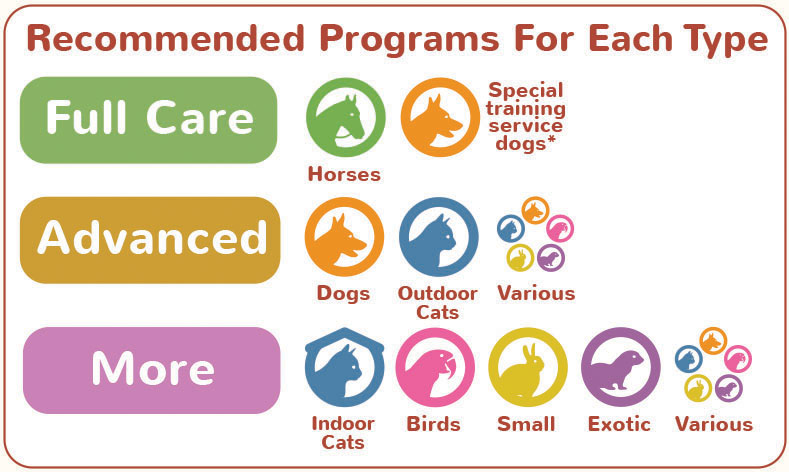
Front Pages Links
Types Solutions
Programs
Overview
Walk through screencast video
Sounds and videos
Try the 5 steps therapy sounds players
Sounds in programs (most types)
Sounds in Solutions for Horses
Sounds in Solutions for Outdoor Cats
Explore the 5 step video therapy
Further Information
Various information from around the web
Short comparison of WeStopFear and conventional process
What is noise phobia or fear of noises?
Conventional Noise Phobia Therapy
Comparing solutions in the market
A new standard practice for pets and horses?
The book
 The book "Pets and Horses Should Not Have To Live In Fear Of Noises", written by the innovator behind WeStopFear and the Simple Secure Steps, is available on Amazon.com as Print version or Kindle version.
The book "Pets and Horses Should Not Have To Live In Fear Of Noises", written by the innovator behind WeStopFear and the Simple Secure Steps, is available on Amazon.com as Print version or Kindle version.
Chapter: About animal types, fear of sounds, and noise phobia (page 23)
Chapter: Is this new method the best method available? (page 147)
The Story: Why and how WeStopFear was developed (page 160)
About the author and developer (page 189)
Merch and designs
The merch collections and DuFauna designs are designed by the innovator behind WeStopFear and the Simple Secure Steps.
Infographics designed by WeStopFear © Copyright.

